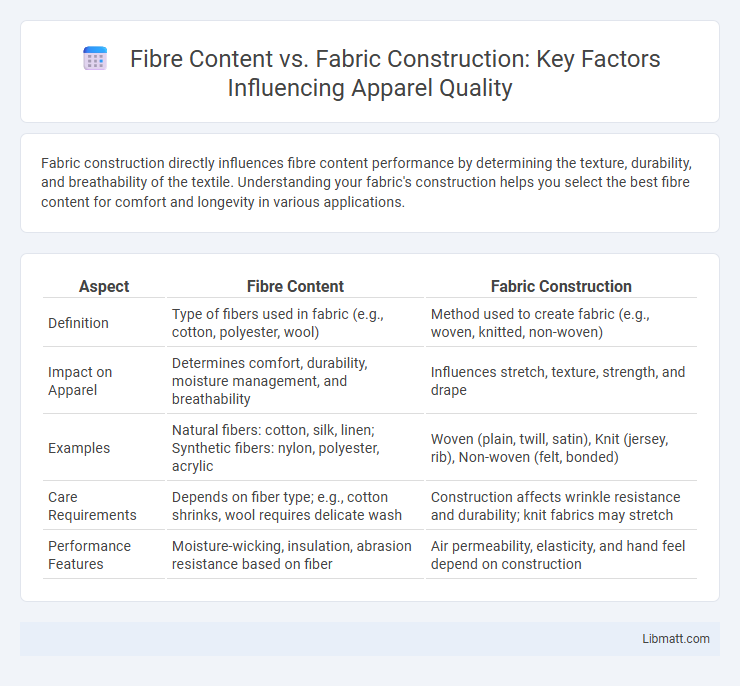Fabric construction directly influences fibre content performance by determining the texture, durability, and breathability of the textile. Understanding your fabric's construction helps you select the best fibre content for comfort and longevity in various applications.
Table of Comparison
| Aspect | Fibre Content | Fabric Construction |
|---|---|---|
| Definition | Type of fibers used in fabric (e.g., cotton, polyester, wool) | Method used to create fabric (e.g., woven, knitted, non-woven) |
| Impact on Apparel | Determines comfort, durability, moisture management, and breathability | Influences stretch, texture, strength, and drape |
| Examples | Natural fibers: cotton, silk, linen; Synthetic fibers: nylon, polyester, acrylic | Woven (plain, twill, satin), Knit (jersey, rib), Non-woven (felt, bonded) |
| Care Requirements | Depends on fiber type; e.g., cotton shrinks, wool requires delicate wash | Construction affects wrinkle resistance and durability; knit fabrics may stretch |
| Performance Features | Moisture-wicking, insulation, abrasion resistance based on fiber | Air permeability, elasticity, and hand feel depend on construction |
Understanding Fibre Content in Textiles
Fibre content determines the fundamental properties of a textile, including durability, moisture absorption, and breathability. Fabric construction methods like weaving or knitting influence the texture and strength but rely heavily on the fibre type for performance characteristics. Understanding fibre content helps you select the right fabric for specific uses, ensuring comfort and longevity in your textiles.
Types of Textile Fibres: Natural vs Synthetic
Natural textile fibers, such as cotton, wool, and silk, originate from plants and animals, offering breathable and biodegradable properties ideal for comfort and sustainability. Synthetic fibers like polyester, nylon, and acrylic are chemically engineered, providing enhanced durability, elasticity, and resistance to wrinkling and moisture. Fabric construction methods, including weaving, knitting, and non-woven techniques, interact with these fiber types to determine the fabric's texture, strength, and performance characteristics.
Defining Fabric Construction Methods
Fabric construction methods determine the structural formation of textiles by interlacing fibers through weaving, knitting, or bonding techniques. Weaving involves crossing warp and weft yarns at right angles, producing durable and stable fabrics, while knitting interloops yarns, creating stretchable and flexible textiles. Bonding uses adhesives or heat to fuse fibers, offering lightweight and nonwoven fabric options suited for specific performance needs.
Weaving vs Knitting: Fabric Construction Techniques
Weaving and knitting are two primary fabric construction techniques that influence fiber content performance and fabric properties. Weaving interlaces fibers at right angles, creating durable, firm fabrics with limited stretch, ideal for structured garments; knitting loops fibers, producing more elastic, breathable fabrics suited for activewear and comfort-focused clothing. Understanding these methods helps you select fabrics that optimize durability, flexibility, and fiber behavior for your specific textile needs.
How Fibre Content Influences Fabric Properties
Fibre content directly affects fabric properties such as strength, durability, breathability, and moisture-wicking ability, with natural fibres like cotton offering softness and breathability while synthetic fibres like polyester provide enhanced durability and wrinkle resistance. The blend of different fibres can optimize performance characteristics, balancing comfort with functionality to meet specific needs. Understanding your fabric's fibre content helps you select materials that suit the intended use and care requirements for better longevity.
The Role of Fabric Construction in Textile Performance
Fabric construction significantly influences textile performance by determining durability, breathability, and texture. While fibre content dictates inherent qualities such as moisture-wicking and strength, fabric construction methods like weaving, knitting, or non-woven bonding control stretch, weight, and air permeability. This interplay shapes end-use functionality, making fabric construction a critical factor in optimizing comfort and performance in textile applications.
Durability: Fibre Content vs Construction Impact
Durability depends significantly on both fibre content and fabric construction, with natural fibres like cotton offering breathability but less resistance to wear compared to synthetic fibres such as polyester, which provide enhanced strength and longevity. Fabric construction methods, including woven, knitted, or non-woven techniques, directly influence tensile strength, abrasion resistance, and stretchability, affecting overall durability. Your choice should balance fibre characteristics and fabric structure to ensure optimal performance and lifespan for the intended use.
Comfort and Breathability: Which Matters More?
Comfort and breathability in textiles depend significantly on both fibre content and fabric construction, with natural fibres like cotton and linen offering superior moisture absorption and softness that enhance comfort. Fabric construction methods--such as knit or woven--affect airflow and stretch, with looser weaves generally providing better breathability. Your choice should balance fibre properties and weave density to achieve optimal comfort and ventilation tailored to your needs.
Cost and Sustainability Considerations
Fibre content directly impacts both the cost and sustainability of fabric, with natural fibers like organic cotton generally being more sustainable but often more expensive than synthetic fibers such as polyester, which are cheaper but less eco-friendly. Fabric construction influences resource consumption; tightly woven textiles require more energy and water to produce but offer durability that can extend garment lifespan, reducing overall environmental impact. Balancing cost and sustainability necessitates selecting fibre blends and fabric weaves that optimize material efficiency and minimize waste throughout production.
Choosing Between Fibre Content and Construction for Your Project
Choosing the right fibre content directly impacts the durability, comfort, and functionality of your fabric, with options like cotton offering breathability and wool providing insulation. Fabric construction methods such as weaving, knitting, or non-woven techniques determine the texture, strength, and stretchability of the material. Evaluating both fibre content and fabric construction ensures optimal performance tailored to the specific requirements of your project, balancing aesthetics and practicality.
Fibre Content vs Fabric Construction Infographic

 libmatt.com
libmatt.com